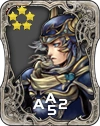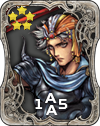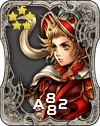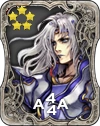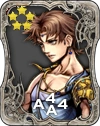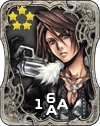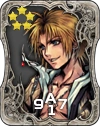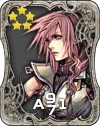The following is a list of allusions to other entries in the Final Fantasy series present in Final Fantasy XIV.
Final Fantasy series[]
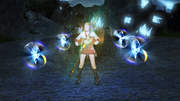
Four crystals appear while using the ability Swiftcast.
- (1.0) Near the end of the cutscene in which Gaius fought Thancred, Y'shtola, Yda, and Papalymo, the four Circle of Knowing members stood a distance from him in a small row. This could be a visual reference to how parties used to stand in rows in the first ten Final Fantasy games.
- Four crystals appear during the animation of the Swiftcast ability, alluding to the four crystals in early Final Fantasy titles.
- In the various promotional screenshots, names of various playable characters from previously released games were used to name the characters.
- A miniature classic airship can be obtained as a pet, as well as a "pointing finger" similar to those used as a cursor in previous entries of the series.
- The CG renders and concept art for the Summoner of Final Fantasy XIV: A Realm Reborn show the summoner with a horn-like adornment on his head, echoing how summoners with forehead horns appear in various Final Fantasy titles. The horn is also present in the class's Artifact Armor.
- The 2013 All Saints' Wake (Halloween) event features a Magic Pot NPC. It resembles the imps of Final Fantasy XI and Final Fantasy XIV hiding in the conventional urn. When players interact with it, it boasts that the Impressario gave it an Elixir and rocks backward gleefully. Magic Pot is a recurring enemy in the series that yields excellent spoils if appeased with an Elixir. There is also a Magic Pot NPC in the Isles of Umbra that rewards the Wind-up Sun and Wind-up Moon minions if given an Elixir and Hi-Elixir.
- Entering most storyline battles initiates the common "whoosh" effect of previous games' random encounters.
- When completing the quest to obtain a Zodiac Weapon Zeta, the "Got an Important Item" jingle plays.
- The summoned creatures of the the Thirteenth are referred to as "Eidolons" in the English localization, reusing the term from several series entries.
Final Fantasy[]
- (1.0) The server Cornelia referred to city and kingdom of the same name.
- (1.0) The server Melmond referred to a village of the same name.
- Matoya, along with her cave and theme tune, are allusions to Matoya from the original title. One of the main scenario quests in the Heavensward expansion is also titled "Matoya's Cave."
- During certain moments of the main scenario, the Warrior of Light and their companions seek the aid of Matoya's Crystal Eye, an ancient crystal ball item that allows the party to find their missing allies. This crystal serves as a reference to the item of the same name that Matoya owned in the original Final Fantasy.
- Matoya becomes a recurring character through the game, appearing as herself and becoming a name Y'shtola adopts as a pseudonym through the Shadowbringers expansion.
- Mount Gulg appears as the level 79 dungeon in the Shadowbringers main scenario.
- The design of the Warrior of Light from the historical texts of the First are based on Yoshitaka Amano artworks of the Warrior and Knight jobs from the original Final Fantasy. During an Echo vision, Elidibus's memories of Azem depict the figure similar to the Warrior of Light's appearance from the texts. Lastly, when fought in the The Seat of Sacrifice trial, his appearance shares the same design of the Warrior of Light artwork.
- Chaos appears as the boss of the Alphascape V1.0 raid instance. He is fought within a destroyed version of the Chaos Shrine. Like his original final boss encounter, his mechanics involve him casting Blaze, Tsunami, Cyclone, and Earthquake.
- In addition, Chaos summons an enemy known as the Dark Crystal during the interlude portion of the fight. This is a reference to the relic of the same name that rested inside the Chaos Shrine in the original Final Fantasy.
- The Warrior of Light's helmet is obtainable for those who purchased the Collector's Edition with the rest being available from the Crystal Tower dungeon.
- The "Wind-up Warrior of Light" minion is based on Yoshitaka Amano's artwork of the Warrior of Light.
- "The Minion of Light," a set of minions based on the Warrior, the White Mage, and Black Mage sprite artwork from the V-Jump strategy guide for the original Famicom version can be obtained as an achievement reward.
- A Wind-up Red Mage was made available to those that pre-orded the Stormblood expansion.
Final Fantasy II[]
- (1.0) The servers Kashuan and Palamecia alluded to, respectively, the kingdom and empire of the same name in Final Fantasy II.
- Minfilia, the leader of the Scions of the Seventh Dawn, uses the password "wild rose" to allow the player to identify other members of the order. This phrase was used by Princess Hilda of Fynn to identify other members of the rebels against the Empire.
- A soundtrack used in multiple places, such as during the main storyline in Ul'dah, is a remix of the battle theme of Final Fantasy II.
- "Dreadnought" is one of the Empire's airships.
- Talking beavers appear in Il Mheg as a type of fae creature.
- Firion's outfit is available for player characters as a Rank 11 Veteran Reward for players who subscribed for 840 days in total. In addition, a set of chocobo barding based on Firion's outfit, as well as a Wind-up Firion minion, are available as achievement rewards.
Final Fantasy III[]
- (1.0) The server Gysahl referred to a village of the same name.
- (1.0) The server Saronia referred to a kingdom of the same name.
- Cid Garlond's airship is named Enterprise. Enterprise first appeared as a name for an airship in Final Fantasy III.
- The Crystal Tower dungeon quests are inspired by the Crystal Tower from Final Fantasy III from the Labyrinth of the Ancients, referring to the Ancients' Maze, to Syrcus Tower. The dungeon is home to various bosses that pay homage to Final Fantasy III enemies. The Labyrinth of the Ancients holds Thanatos, King Behemoth, and Phlegethon (named Titan in Japanese), whereas Syrcus Tower has Scylla, Glasya Labolas (named Guardian in Japanese), Amon, and Xande. The Cloud of Darkness appears along with World of Darkness as the final boss of the Crystal Tower arc. The themes "Altar Cave," "Battle 2," and "The Crystal Tower" have been rearranged for the raids.
- When casting his ability, Glasya Labolas will make the same pose as his Final Fantasy III sprite.
- Xande's obsession with his mortality and fear of the inevitable lead him to make a pact with a being from the void, the Cloud of Darkness, mirroring his ambitions in Final Fantasy III.
- Doga and Unei are named after the two sages from Final Fantasy III.
- The historical figures from the Allagan Empire are named Desch and Salina, referencing the original Desch and Salina from Final Fantasy III.
- The Wind-up Magus and Wind-up Viking enemies inside of the Antitower are based on the Magus and Viking jobs, being based on their sprites from the original NES version.
- The Warriors of Darkness are based on the characters of the same name from Final Fantasy III. Similar to the characters they are based on, Ardbert and his companions come from a world that is being consumed by the Flood of Light.
- In addition, the job titles for Ardbert's companions are from the jobs in Final Fantasy III: Devout, Magus, Ranger and Knight. However, due to Knight being used as the Japanese name for Paladin job in Final Fantasy XIV, Branden's job title in Japanese is instead Magic Swordsman (魔法剣士, Mahōkenshi?), using the Japanese name for the Dark Knight job in Final Fantasy III.
- The Onion Helm is a helmet available to players who purchased the Collectors Edition of the original game, the rest of the Onion equipment is available as prizes in the Crystal Tower. Onion equipment debuted in Final Fantasy III with the Onion Knight job.
- The Artifact Equipment for the Summoner job class is called the "Evoker's equipment" and the upgraded version is the "Summoner's equipment", allusions to the job Evoker and its upgraded version, the Summoner from Final Fantasy III.
- All of the weapons that can be purchased with Rowena Tokens gained from the quest Primal Focus are named after weapons in Final Fantasy III. These weapons are used by the same jobs in each game with two exceptions: the Elder Staff and Omnirod are swapped, with the former used by White Mages in Final Fantasy III and the latter used by Black Mages.
- According to the Final Fantasy XIV: Heavensward | The Art of Ishgard – Stone and Steel – artbook, the Orison set of equipment for the White Mage job is based on the White Mage robe in Final Fantasy III.
- The minion "Wind-up Onion Knight" can be found in a treasure chest after the party defeats Xande. It is based on the original NES sprite of the Final Fantasy III Onion Knight.
- Nepto Dragon can be fished by the Fisher class, named after the creature from the original game.
Final Fantasy IV[]
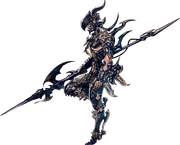
Dragoon artwork with Kain Highwind's famous pose.
- (1.0) The server Mysidia referred to a village of the same name.
- (1.0) The server Fabul referred to a kingdom of the same name.
- The Artifact Armor for Dragoon is a reference to Kain Highwind's armor. The artwork of the Dragoon job shares the same pose as Kain in the original logo of Final Fantasy IV. The icon for the skill Blood Of The Dragon also features the pose.
- Nidhogg's second stage in The Final Steps of Faith, which sees him take the form of Estinien Wyrmblood, strikes the same pose as Kain's logo in his passive stance.
- A weather vane seen in the Heavensward cinematic is shaped like Yoshitaka Amano's original Final Fantasy IV logo featuring Kain Highwind.
- The final boss of the Antitower, Calcabrina, is a reference to the dancing doll demon Calcabrina, even sharing the same theme music.
- The final boss of the Burn, Mist Dragon, is a reference to Mist Dragon.
- The healer role quest giver in Shadowbringers is a dwarf NPC named Giott, borrowing their name from King Giott from Final Fantasy IV.
- The dwarf village of Tomra in the Kholusia region is named after the dwarf village of the same name from Final Fantasy IV.
- During the Seat of Sacrifice trial, the Warrior of Light will summon a lalafell Spectral White Mage and Black Mage to perform Twincast to unleash meteor circles on the field, referencing the characters Palom and Porom and their Comet Twincast spell.
- In the trailers of Endwalker, The Warrior of Light is presented as a Paladin standing on the moon. Both concepts are heavily introduced in Final Fantasy IV: Paladin being Cecil Harvey's main job in the game, and the Red Moon being a important location in the game.
- Fandaniel's Lunar Primals from the final portions of Shadowbringers—Lunar Bahamut, Ifrit, Odin, and Ravana—are based on the Lunar Eidolons that appear in the Game Boy Advance and Complete Collection versions of Final Fantasy IV. Lunar Bahamut, Lunar Ifrit, and Lunar Odin also share the same color-schemes of the bosses they are based on from the original game.
- During the initial main scenario of the Endwalker expansion, the Magus Sisters appear as a set of Lunar Primals summoned within the Tower of Zot, all serving as the dungeon's boss encounters. Each boss encounter has them using their respective spells from Final Fantasy IV, with their final encounter relying on the group utilizing Reflect-based fighting tactics in some manner.
- In addition, when Minduruva performs any of her magic-based attacks, the casting animation is accompanied by the same sound effect used for Rydia's summon magic.
- The Tower of Babil dungeon is named after the dungeon of the same name from Final Fantasy IV. Like its predecessor, the dungeon is located near the Eblan region and opens the path to the world's moon.
- The Mare Lamentorum location is heavily based on the Red Moon, having an antagonist sealed within its depths and a crystalline structure on its surface. The crystals within the structure are blue and orange, referencing the Light and Dark Crystals of Final Fantasy IV.
- The Watcher character is based on Fusoya, being a purple-robed figure that guards the antagonistic force sealed on the moon.
- The Thirteenth's moon is also based on the Red Moon, evening sharing "Another Moon" as its musical theme.
- The Loporrits directly reference the Hummingways, resembling the race from the 3D remake of Final Fantasy IV, whom also live on the moon and make the same humming noise the race is known for.
- A majority of the Loporrits' names originally appeared in the 3D remake, being aliases Namingway took during his sidequests.
- When the Warrior of Light is incapacitated during the final battle of Endwalker, the Warrior's party is revived thanks to the prayers of their allies, similar to the final battle with Zeromus in Final Fantasy IV. In addition, the descriptions of each prayer are directly taken from the original game.
- The Kingdom of Troia is a location on the Thirteenth, being named after the nation from Final Fantasy IV. Like the original, it was once ruled by a circle of leaders known as the Epopts. The location also uses an arrangement of the "Troian Beauty" as its background theme.
- The English localization uses Eidolon as the term to refer to Primals on the Thirteenth, borrowing the name for summoned creatures from later English releases of Final Fantasy IV.
- A version of Golbez original to the universe of Final Fantasy XIV appears as the main villain of the post-release storyline of the Endwalker expansion.
- Like his original boss encounter, the Golbez of Final Fantasy XIV fights alongside the Shadow Dragon. In addition, he also has access to the Binding Cold and Black Fang abilities.
- When empowering his greatsword with the Shadow Dragon's power, Golbez will mimic Dark Knight Cecil's pose when performing the Darkness ability.
- Like Final Fantasy IV, the Elemental Archfiends appear as Golbez's loyal servants and are fought throughout the post-release storyline of Endwalker as dungeon and trial bosses. Their appearances are heavily inspired by their original artworks by Yoshitaka Amano.
- Each encounter with archfiends reference their original counterparts in several ways:
- All archfiends use variations of their signature attacks from their original boss encounters.
- Their boss encounters use arrangements of "Battle 2" and "Battle With the Four Fiends".
- The English version reuses Scarmiglione, Barbariccia, and Cagnazzo's titles from the localization of the 3D remake of Final Fantasy IV.
- Like the original game, Scarmiglione is the first archfiend fought and is considered the weakest of his peers. His dungeon boss encounter is based on his first boss fight - being in his cloaked form, summoning undead servants during the encounter, and uses "Battle 2" as his boss theme.
- Barbariccia transforms into her tornado form during her boss encounter. When the party is attacked by her minions prior to their arrival at the Storm's Crown, Estinien remarks, "You're not the only ones who can ride the wind.", referencing Kain Highwind's dialogue prior to Barbariccia's boss encounter in Final Fantasy IV.
- Like his original counterpart, Rubicante is the most human of the archfiends, retaining his sense of honor and respect towards the protagonists. When performing Blazing Rapture during his boss encounter, Rubicante will exclaim, "Allow me to show you a real flame!", mirroring his original statement to Edge Geraldine prior to casting Inferno.
- Each encounter with archfiends reference their original counterparts in several ways:
- Rubicante's boss encounter is named Mount Ordeals, being named after the original location from Final Fantasy IV.
- The Octomammoth is fought as the final boss of the Aetherfont, borrowing its design from its original Final Fantasy IV appearance.
- The Kingdom of Baron was a location on the Thirteenth during the events of the Contramemoria, being named after the nation from Final Fantasy IV.
- The Zeromus voidsent is based on the final boss of Final Fantasy IV.
- The non-playable character for the Bard quests says the phrase "Call me a spoony bard, but...", in reference to the famous one-liner from Tellah.
- The players will encounter a "darkness" version of themselves during one of the Dark Knight job quests, similar to the event in Final Fantasy IV.
- The Allagan ADS enemies are based on the CPU boss from Final Fantasy IV.
- The first final boss of Pharos Sirius (Hard), the Progenitrix, is based on the Mom Bomb boss from Final Fantasy IV. In the Japanese version, the boss is called "Mother Bomb" (マザーボム, Mazā Bomu?). Like in the original game, she also spawns Grey Bombs.
- Like the Lunar Ruins post-game dungeon from Final Fantasy IV, the entrance of the Smileton post-game dungeon is located at the Stone Face on the moon.
- The Evil Dreamer enemies within the Fell Court of Troia are based on the enemy of the same name. Like their original counterparts in Final Fantasy IV, they are fought in large groups and use fire-themed magicks.
- The SNES version of the battle theme from Final Fantasy IV plays when encountering an enemy in Bestways Burrow.
- Arrangements of "Sorrow and Loss" and "Suspicion" are used as background themes for specific locations and cutscenes for the Endwalker post-release storyline.
- The Artemis' Bow, the Relic Weapon for Bards, was long ago crafted specifically for a man named Gilbert, which is the Japanese name for the character Edward Chris von Muir, who was a Bard.
- Cecil's Paladin headband and earrings could be obtained by pre-ordering Heavensward.
- The final line on the card that provides the item code is "May they take you back to a time when two was four and four was two," a reference to how Square titled the SNES version of Final Fantasy IV as Final Fantasy II for the western market.
- The Tantra set of equipment for Monk job is based on Yang Fang Leiden's Yoshitaka Amano's artwork.
- The Lunar Whale was introduced as a mount during the 2021 virtual Fanfest. The mount's appearance is based on the Yoshtaka Amano artwork of the aircraft.
Final Fantasy IV -Interlude-[]
- The second final boss of Pharos Sirius (Hard), the Progenitor, is based on the Dad Bomb boss from Final Fantasy IV -Interlude-. In the Japanese version, the boss is called "Father Bomb" (ファザーボム, Fazā Bomu?).
Final Fantasy IV: The After Years[]
- The Meteia are similar to the Maenads, being an artificial series of humanoid females that possess a hive mind and assess the state of another world's inhabitants before ultimately wiping them out.
- Golbez's appearance during the past events of the Contramemoria is based on his appearance as the "Man in Black" from The After Years.
Final Fantasy V[]
- (1.0) The server Istory referred to a town of the same name.
- (1.0) The server Karnak referred to a town of the same name.
- (1.0) During Caravan Security, both "Boco" and "Koko" may appear as the chocobo names. Boco was Bartz Klauser's steed in Final Fantasy V who, during the game, found a girlfriend named Koko.
- Sastasha is a homage to the Pirates' Hideout from Final Fantasy V. Both locations serve as the first dungeon.
- The Guardian Tree can be found in the Central Shroud. It's an allusion to the Guardian Tree on Planet R of Final Fantasy V.
- A character based on Final Fantasy V lead character Krile Mayer Baldesion appears, designed after her namesake in White Mage attire.
- Krile's grandfather, Galuf, borrows his name from the original Galuf Halm Baldesion. In the Eureka storyline, it is revealed he traveled with companions named Xezat, Kelger, and Dorgann; being named after the other Warriors of Dawn that accompanied Galuf.
- Krile is also part of the Students of Baldesion, a group of researchers formerly located on the Isle of Val. In Final Fantasy V, Galuf and Krile hailed from the kingdom of Bal and their surname was "Baldesion".
- Several locations in Eureka are named after Final Fantasy V characters: Port Surgate, Klauser's Howe, The Val River Swale, and Klauser's Peace.
- The Great Gubal Library dungeon is loosely based on the Library of the Ancients dungeon from Final Fantasy V. The enemy Page 64 and the boss Byblos are based on the enemies of the same name encountered in the Library of the Ancients.
- Omega appears as an ancient superweapon while Shinryu appears as a primal, thus making them rivals just like in the lore of Final Fantasy V.
- The Ship Graveyard in Western La Noscea and the Sirensong Sea dungeon are both inspired by the Ship Graveyard.
- In the main story quest, History Repeating, the player fights Siren in the Ship Graveyard.
- The First was once home to an ancient civilization known as the Ronka, who left a number of ruins behind, a reference to the Ronka Ruins.
- The Night's Blessed's original settlement, Fort Gohn, is named after the village of the same name from Final Fantasy V. Similar to the original, Fort Gohn is a ruined village that is located near the ruins of the ancient Ronkan civilization.
- The musical theme that plays within the Old Sharlayan headquarters of the Students of Baldesion is an arrangement of "The Day Will Come" from Final Fantasy V.
- Gilgamesh makes an appearance in the game and fights the adventurer during Hildibrand storyline. A green chicken named Enkidu also appears alongside him in honor of his partner from Final Fantasy V. Lastly, a primal in the form of the Enkidu from Final Fantasy V appears later in the story.
- In the cutscene just before the second phase of the "Battle in the Big Keep" trial, Gilgamesh recites almost verbatim his pre-battle lines from Final Fantasy V.
- Catoblepas, the second boss of Halatali (Hard Mode) is based on the optional boss and summon from Final Fantasy V.
- Atomos, a boss in the Labyrinth of the Ancients, is based on the boss of the same name from Final Fantasy V.
- Ice Soldiers are summoned as additional enemies during the fight with Shiva, possibly in reference to the Ice Commanders that fight alongside Shiva in Final Fantasy V.
- Karlabos, the first boss of Sastasha (Hard), is based on the boss of the same name from Final Fantasy V; additionally, his signature attack is Tail Screw, and like in Final Fantasy V, it reduces the target's HP to critical levels.
- Calofisteri, the final boss of The Weeping City of Mhach, is based on the boss of the same name.
- Gaelicats in the Sea of Clouds area are based on an enemy of the same name from Final Fantasy V.
- Bandersnatches in Dravanian territories have the same design as their Final Fantasy V counterparts.
- The Enchanted Fan enemies in Sohr Khai are based on the enemy of the same name from Final Fantasy V.
- The Liquid Flame and Living Liquid bosses can transform into three forms: human form, hand form, and tornado form, alluding to the Liquid Flame battle in the Fire-Powered Ship.
- The Interdimensional Rift is a direct reference to the final dungeon of Final Fantasy V. The background music is an arrangement of "Prelude to the Void" and the boss battle theme is an arranged version of "Battle 2".
- The bosses of the Deltascape raids are based on Final Fantasy V bosses: Alte Roite, Catastrophe, Halicarnassus, and Exdeath. For the last boss, Exdeath, an arrangement of "The Decisive Battle" serves as the background music.
- Exdeath uses the power of the Void in battle. Furthermore, the animation of his Flare and Holy are based on their Final Fantasy V versions.
- The final boss of the Masked Carnivale, Azulmagia, serves as a reference to the Blue Mage enemy of the same name. In addition, players receive his signature cane as the level 50 Blue Mage weapon.
- Artifact gear for the Blue Mage is based on the job's Final Fantasy V counterpart.
- The casting effect of Blue Magics is also based on Final Fantasy V Blue Magic casting.
- The final boss of the Twinning dungeon is named The Tycoon, being named after kingdom of the same name from Final Fantasy V. Due to the enemy being a palette swap of the castle-like primal Alexander, the enemy's name is a reference to Castle Tycoon or possibly Lenna’s father, Alexander Highwind Tycoon.
- There is a sidequest in the Dravanian Forelands where the player has to obtain Wyvern Tails, a grass-like plant found growing on the northern hills, and use them to heal a wyvern's wounds. In Final Fantasy V, the party must venture to Drakenvale to find dragon grass to heal a wind drake.

Moai face underwater.
- There is a moai face in the Lochs in Stormblood, alluding to the moai statue at the bottom of the ocean in Final Fantasy V.
- A Ghido minion can be obtained from the last treasure chest in The Sirensong Sea. It is based on the turtle sage Ghido and will fight with the Wind-up Exdeath minion.
Final Fantasy VI[]

A Terra lookalike in the Magitek Armor trailer for Final Fantasy XIV: A Realm Reborn.
- (1.0) The server Figaro referred to a kingdom of the same name.
- (1.0) During the 2011 All Saints' Wake (Halloween) event, the trickster imps would randomly say "Life... Dreams... Imps... Where do they come from? And where do they go?" upon spawning, quoting Kefka's speech during the final battle of Final Fantasy VI.
- The first video showing the Magitek Armor in-game was a short recreation of the opening to Final Fantasy VI, with a green haired female hyur and two other characters riding the Magitek Armor in a snowy region, and a remix of "Terra's Theme" playing in the background. As of Patch 2.55, the remix of "Terra's Theme" is now the mount music for the Magitek Armor.
- The Garlean Empire's technology is called magitek, and has advanced considerably due to the works of a Cid and is primarily used for military purposes. Additionally, two versions of the Magitek Armor mount is available to players: one based more on Yoshitaka Amano's "armless" design seen in concept art, and the "armored suit with arms" design seen in the game as printed. In Final Fantasy VI, magitek technology is employed by the Gestahlian Empire, invented by the engineer Cid Del Norte Marguez.
- When Cid nan Garlond is suffering from amnesia, he goes by the name Marques, referring to the Cid from Final Fantasy VI.
- There is a Phantom Train linking several Garlean Castra. During the main story quest "Escape from Castrum Centri," Yda and Y'shtola sneak into the Imperial stronghold using the train, and a depot is briefly visited during runs through Castrum Meridianum. Phantom Train was a supernatural train in Final Fantasy VI that the party accidentally boards and must escape from.
- The floating continent of Azys Lla is inspired by the Floating Continent from Final Fantasy VI. The connection is further established by several nods:
- The Garlean Legion encountered in Azys Lla is the VIth Legion.
- "Proto Ultima," a creature based on the Ultima Weapon, can be seen flying around the continent. The Ultima Weapon is a boss fought on the Floating Continent in Final Fantasy VI.
- The Aetherochemical Research Facility instance dungeon in Azys Lla houses three primals known as the Warring Triad. The exterior of the dungeon in the open world also houses golden statues of the Warring Triad around a tower-like object. The three primals are eventually fought in separate instances and all use Battle to the Death as their first phase battle theme.
- The appearance of the Ultima Beast, a prototype Ultima Weapon fought in the Fractal Continuum (Hard), is based on the version of the Ultima Weapon from Final Fantasy VI.
- Doma is the name of a nation-state far across the sea from Eorzea, and when it resists the control of the Empire, it is wiped out as an example to other nations. Doma in Final Fantasy VI is also wiped out after resisting the Gestahlian Empire. In addition to this, like its Final Fantasy VI counterpart, Doma contains elements based on feudal Japan.
- Both the former Doman king, Kaien and the prince, Hien, are direct references to the characters Cyan Garamonde and his son Owaine. Kaien's name is based on the romaji of Cyan's Japanese name, Cayenne (カイエン, Kaien?), while Hien's childhood name, Shun, is based on Owaine's Japanese name, which is also Shun (シュン, Shun?). An arrangement of "Cyan's Theme" plays as Hien's character theme.
- The party finds Hien on a cliff similar to how Cyan was found in the World of Ruin in Final Fantasy VI.
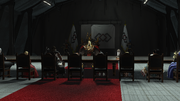
A parley between Eorzean Alliance and Emperor Varis.
- Later in the Stormblood main scenario, there's a meeting between the Eorzean Alliance and Emperor Varis zos Galvus, this event resembles the event where The Returners have a dinner with Emperor Gestahl. The parley also split into two parts with a short break, where the player can speak to various NPCs.
- An airship named Blackjack appears during the Ixal quests. The Blackjack can also be purchased as a player mount. Blackjack was Setzer Gabbiani's airship in Final Fantasy VI.
- The Alchemists' Guild quest line revolves around the Guildmaster attempting to bring his lover back to life, who succeeds in doing so just long enough to say goodbye, a reference to the story of Locke and Rachel.
- The Scholar Limit Break, Angel Feathers, is based on the Esper Seraph's ability of the same name.
- A historical moogle warrior by the name of Mog is mentioned by Estinien when spoken to at Mog Home in The Churning Mists, referencing Mog from Final Fantasy VI.
- Moglin, Moghan, and Mogwin are named after the moogles from Final Fantasy VI.
- A Lupin going by the moniker "The Wolf Burgler" appears in the Hildibrand story, at one point forcing you to choose between your ally or the precious item falling from a cliff much like in Final Fantasy VI.
- Ultros and Typhon make a cameo appearance as optional bosses in the Hildibrand storyline and are fought in the "The Dragon's Neck" trial instance. Ultros is a recurring boss and comic relief character in Final Fantasy VI who has a friend named Typhon, both were forced to work in the Dragon's Neck Coliseum during the World of Ruin portions of the game. In addition, Ultros also uses direct quotes from Final Fantasy VI several times during his cutscenes.
- Ymir appears as a boss in the Hullbreaker Isle (Hard). A group of Ymir Unshelled also appear in the cave before the boss room of Ymir.
- The first boss of Dun Scaith is "Deathgaze Hollow", whose battle occurs on the deck of an airship. This alludes to the battle against Deathgaze in Final Fantasy VI.
- The Stormblood dungeon, Castrum Abania has many enemies and bosses from Final Fantasy VI, including but not limited to the Magna Roader, Number 024, and Inferno each possessing many of the same attacks and battle strategies.
- Kefka also appears as the final boss of the fourth version of Sigmascape, being preceded by Phantom Train, Chadarnook, and Guardian alluding to his role as the main antagonist in Final Fantasy VI. He also uses various lines from both the SNES/PSX as well as the GBA/iOS/Steam versions of Final Fantasy VI during his fight against the party. During the final phase, Nero tol Scaeva when Kefka uses Forsaken for the first time will state "He's gone beyond chaos... the end approaches!" alluding to Kefka's line in the SNES version when charging up the attack, "The end comes... beyond chaos...".
- The Monk, Machinist, and Samurai jobs have combat actions based on battle commands from Final Fantasy VI: the Monk's Masterful Blitz actions being based on Sabin's Blitz, the Machinist's tool weaponskills being based on Edgar's Tools, and the Samurai's Hissatsu abilities being based on Cyan's Bushido.
- There's a Gladiator skill called "Riot Blade," a Dragoon Jump named "Mirage Dive", and a Samurai skill called "Tsubame Gaeshi". These skills are named after the Desperation Attacks of Terra, Locke, and Cyan.
- Setzer's costume can be bought in Manderville Gold Saucer.
- The Falcon is an available mount as of Stormblood. References to original are present in the mount description, claiming it is the fastest airship in the world that crashed when out flying, the latter referencing Darill's Falcon airship crashing.
- The Pictomancer job introduced in Dawntrail is based on Relm Arrowny. Its level 100 artifact gear is also inspired by Relm's outfit.
- The Gestahl dog minion is a reference to a joke where the Emperor Gestahl sprite in Final Fantasy VI looked like a dog.
Final Fantasy VII[]
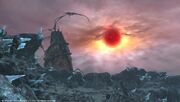
The fall of Dalamud event alludes to Meteor in Final Fantasy VII.
- (1.0) The server Wutai referred to a nation of the same name from Final Fantasy VII.
- (1.0) When the player underwent the first "Horn & Hand" faction leve, a NPC said the following: "Why, if it isn't Sephiroth! Or was it Sephiross? Setirophx? xXxSephirothxXx?", referring to the Final Fantasy VII main antagonist Sephiroth and common variations used to name characters on MMOs (and by proxy, Final Fantasy XIV itself—although of comical note is due to the game's naming conventions, some of the variations are not possible in XIV itself).
- (1.0) An NPC in the Miner quests mistakenly called players by the wrong name. He called a Midlander Hyur "Cloud," and a Miqo'te "Aerith," both main characters from Final Fantasy VII.
- The VIIth Imperial Legion leaders reference the antagonists of Final Fantasy VII.
- Nael van Darnus takes after Sephiroth in being driven insane by an otherworldly being that compels them to execute a Meteor ritual that succeeds posthumously, referenced by others long after. Even her exit in the "United We Stand" quest is similar to that of Sephiroth in the Nibelheim burning scene.
- Valens van Varro takes after Professor Hojo as a sociopath with a penchant for human experimentation.
- Biggs, Wedge, and Jessie borrow their names from the AVALANCHE members from Final Fantasy VII. All three are members of Garlond Ironworks.
- During the quest "The Company You Keep," Biggs and Wedge are found at the crash site of an airship called the Tiny Bronco. Tiny Bronco was Cid Highwind's airplane in Final Fantasy VII.
- While between missions during the Dreams of Ice story missions, Yda competes at squats with Hoary Boulder, referring to the minigame from Final Fantasy VII. The squats are also an unlockable emote for player characters.
- The primal King Thordan and his Knights Twelve allude to the Knights of the Round from Final Fantasy VII.
- During the final battle, their attacks go off in the same order as the summon animation in Final Fantasy VII.
- After the last attack of King Thordan's Ultimate End, the screen "shatters."
- A variant of Ultimate End is also performed during a cutscene in the final Hildibrand quest in Heavensward.
- The secondary antagonist of the Shadowbringers expansion, Vauthry, was infused with the essence of a Lightwarden while within his mother's womb to augment him and grant him the ability to control sin eaters. Vauthry believes the world is rightfully his to rule as a god. These elements mirror Sephiroth's role in Final Fantasy VII, including being injected with Jenova cells while Lucrecia Crescent was still pregnant with him, and believing Gaia is rightfully his and Jenova's. Similar to Sephiroth, Vauthry's ascended form has angelic traits.
- The city of Amaurot is similar to the City of the Ancients, with both locations being the home to a race known as the "Ancients", and are both located within a coral valley environment.
- During the finale of the Shadowbringers main scenario questline, Emet-Selch reveals to the Warrior of Light his true identity as Hades. His first form's appearance is heavily inspired by the summon's appearance in Final Fantasy VII and even has access to the summon's Black Cauldron ability as his final enrage attack.
- After defeating the final boss of the Endwalker expansion, the Warrior of Light and Zenos Galvus engage in a one-on-one battle, mirroring Cloud and Sephiroth's post-final boss fight from the ending of Final Fantasy VII. Like the original battle, it begins with a stand-off between the two.
- A sidequest storyline in The Fringes involves a Miqo'te who believes that his father abandoned him as a coward. He later learns that, in reality, his father died protecting their village from monsters whose poison turned him to stone. This alludes to the story of Red XIII and his father.
- A small resort town named Costa del Sol is located in La Noscea, named after a similar place in Final Fantasy VII.
- Revenant's Toll features a tavern called Seventh Heaven—named after the bar and restaurant owned and run by Tifa Lockhart in Final Fantasy VII. The owner jokes that she was going to call the bar "Cloud Nine," but thought it would be too effeminate for the clientele.
- Manderville Gold Saucer is inspired by the Gold Saucer from Final Fantasy VII.
- The city of Eulmore contains a pleasure club known as "The Beehive", the bonded workers who dance in the club are known as "honeybees". The club and the name of the dancers are a reference to the Honey Bee Inn from Final Fantasy VII.
- The Ultima Weapon resembles the Ultimate Weapon from Final Fantasy VII, one of the Weapons awakened by Sephiroth.
- The first boss of the Ala Mhigo dungeon, Magitek Scorpion, is modeled after Guard Scorpion. An NPC in the dungeon similarly references Cloud's battle text to "Attack when the tail is up," which will force the boss' tail laser to end earlier. (This also pokes fun at players who did not wait for the second text box to appear in the boss battle in the original game, where it would explain that attacking the boss while its tail was up would cause it to counter-attack. The second text box would not appear if the user used magic, summon, etc. before or during the explanation.)
- The first boss fought in the Anamnesis Anyder dungeon, Unknown, is a reference to the Unknown (Final Fantasy VII) enemy found in the sunken Gelnika transport airship. While the Final Fantasy VII enemies were discarded experiments made by Professor Hojo, given the nature of the dungeon in Final Fantasy XIV, it is likely these Unknown were concepts made by the ancient Ascians through creation magic and similarly discarded.
- Shadowbringers features four Ultima Weapon-based prototypes developed by Nael's successor Valens van Varro: the Ruby, Sapphire, Emerald, and Diamond Weapons. Similar to how the Sapphire Weapon in Final Fantasy VII isn't fought by the party, the Sapphire Weapon in Final Fantasy XIV is only fought in a solo duty instead of a trial instance, with said solo duty taking place over a body of water.
- The Dragonfire Dive (Dragon Dive in Japanese) ability used the Dragoon job borrows its name from the Limit Break of the same name used by Cid Highwind.

The Buster Sword appearing during the Braver Limit Break.
- Various Limit Breaks that originate from Final Fantasy VII appear: Braver, Healing Wind, Breath of the Earth, Ungarmax, Final Heaven, Pulse of Life, Chimatsuri, Satellite Beam, and Doom of the Living. In addition, the Dragoon’s Dragonsong Dive visually homages the finale of Cid Highwind’s Dragon Dive Limit Break.
- Cloud's Buster Sword is used when the player performs Braver and Sword Dance, the level 1 and 2 melee Limit Breaks.
- A light form of Aerith's Guard Stick is used when the player performs healer Limit Breaks as a White Mage.
- The Materia crafting system is named after and inspired by Final Fantasy VII Materia.
- The Dark Knight's victory pose, as well as its idle pose for male characters, resemble Cloud's poses.
- The Samurai's weapon-drawn pose resembles Cloud's in-battle idling animation from the original Final Fantasy VII, while the /cpose animation for male characters resembles Sephiroth's victory pose.
- The achievement for defeating Sephirot on Extreme difficulty is "Veni, Veni, Venias", a line from "One-Winged Angel".
- The quote of the Cait Sith Doll minion is "What may be a few to you was everything to those who died...", a line Cait Sith said to Barret in Final Fantasy VII in regard to collateral damage caused by AVALANCHE.
- The Japanese name of the Savage variant of the Second Coil of Bahamut is the "Great Labyrinth of Bahamut Type-0" (大迷宮バハムート零式, Dai Meikyuu Bahamūto Reishiki?), referring to the Japanese name of the Bahamut ZERO summon, who first appeared in Final Fantasy VII.
- The Lifestream is an afterlife concept originating from Final Fantasy VII as the place where souls go when a living thing dies only to then be reincarnated in a new form.
- Joe makes a cameo as 'Joseph', a male Hyur in the Manderville Gold Saucer who stands in the Chocobo Square where the player is able to race Chocobos.
- A background NPC near Joe will reference Teioh, who is raced by Joe in Final Fantasy VII. The NPC laments being unable to beat Teioh.
Final Fantasy VII: Advent Children[]
- Cloud's Advent Children outfit is available to players as a Veterans Reward for subscribing.
- The SDS Fenrir mount description mentions it was once used by members of the now-defunct Strife Delivery Service, referencing the delivery service of the same name started by Cloud in Advent Children.
- Cloud's hairstyle in Advent Children is awarded to winners of the art contests held in the Lodestone.
Final Fantasy VIII[]
- (1.0) The server Trabia referred to continent and Garden of the same name.
- One of the Garlean Empire's main infantry weapons is a variant of a gunblade, a weapon originating from Final Fantasy VIII, though the functionality is different from those seen in VIII.
- The Sharlayan space exploring vessel in Endwalker is named the Ragnarok, which borrows its name from the space traveling airship from Final Fantasy VIII.
- The Triple Triad card game originates from Final Fantasy VIII.
- The Gunbreaker class is heavily based on Squall Leonhart and Seifer Almasy, using a different style of gunblade than the Garlean models based on the Final Fantasy VIII version.
- The Keen Edge, No Mercy, Brutal Shell, Demon Slice, Lightning Shot, Solid Barrel, Rough Divide, Gnashing Fang, Savage Claw, Fated Circle, and Blasting Zone abilities used by Gunbreakers are all based on abilities used by either Squall or Seifer in Final Fantasy VIII or their crossover appearances.
- One of the Leatherworking tradecraft levequests added in Heavensward is called "Maybe He's A Lion."
- Tonberry King is the final boss of the Wanderer's Palace, referring to the boss in Final Fantasy VIII.
- Diabolos is the final boss of the Lost City of Amdapor, and its entrance (emerging from a dark orb, surrounded by bats) strongly resemble that of its Final Fantasy VIII incarnation.
- Quetzalcoatl is a boss in the Akadaemia Anyder, using its appearance from Final Fantasy VIII. Its intro cutscene refers to it as a Guardian Force.
- The first sin eater, Eden, is based on the Guardian Force of the same name. Eden also serves as the focus of the raid series of Shadowbringers, containing several references to Final Fantasy VIII.
- The Eden Prime boss uses Eternal Breath as its special attack, recreated from the Final Fantasy VIII summon animation.
- The boss of
 Eden's Promise: Anamorphosis, the Fatebreaker, refers to Griever. Like Griever is made manifest from Squall's impression of strength, the Fatebreaker is made from Ryne's memories.
Eden's Promise: Anamorphosis, the Fatebreaker, refers to Griever. Like Griever is made manifest from Squall's impression of strength, the Fatebreaker is made from Ryne's memories. - Gaia takes after Ultimecia in visual design, abilities, and seeking to create a timeless world after being reawakened as Loghrif. Even the
 Eden's Promise: Eternity (Savage) version plays similar to the penultimate and final boss battles, including time compression and the Oracle of Darkness's usage of Hell's Judgment and Shockwave Pulsar. Gaia also combines aspects of Squall (monologue and hazy memories), Rinoa (having sorceress abilities and being possessed), and Laguna (hearing a faerie's voice in her head and getting leg cramps), and references an Ultimecia line: "Time... It won't wait."
Eden's Promise: Eternity (Savage) version plays similar to the penultimate and final boss battles, including time compression and the Oracle of Darkness's usage of Hell's Judgment and Shockwave Pulsar. Gaia also combines aspects of Squall (monologue and hazy memories), Rinoa (having sorceress abilities and being possessed), and Laguna (hearing a faerie's voice in her head and getting leg cramps), and references an Ultimecia line: "Time... It won't wait."
- The finale of the raid series has Gaia wandering in an empty void, only to be saved by Ryne calling out to her, with the two appearing in the flower fields of the Empty. These scenes mimic the ending of Final Fantasy VIII, with Squall being saved by Rinoa and appearing in the flower fields outside of Edea's House.
- In addition, the scenes of Gaia wandering in the void mimic the animations and shot compositions of the scenes of Squall wandering in the empty deserts during the final cutscenes of the original game.
- The tracks "Blue Fields", "Force Your Way", "Don't Be Afraid, "The Legendary Beast", "The Extreme", portions of "Ending Theme", and "Ami" play during specific raid encounters and story scenes.
- The finale of the raid series has Gaia wandering in an empty void, only to be saved by Ryne calling out to her, with the two appearing in the flower fields of the Empty. These scenes mimic the ending of Final Fantasy VIII, with Squall being saved by Rinoa and appearing in the flower fields outside of Edea's House.
- Eyes on Me is an enemy ability used by All-Seeing Eye, the boss in Dzemael Darkhold. This refers to the theme song from Final Fantasy VIII.
- The Double and Triple abilities are used by certain Ascians during specific boss encounters, like the same spells that first appeared in Final Fantasy VIII, allow the user to cast magic multiple times. The animations for the abilities strongly resemble the Double and Triple spell animations originally used in Final Fantasy VIII.
- The Level 2 Ranged DPS Limit Break is called Desperado.
- Zell Dincht's tattoo is available in Character Creation mode.
- Squall's outfit is available to players as a Veterans Reward for subscribing.
Final Fantasy IX[]
- (1.0) The server Lindblum referred to the regency of the same name.
- (1.0) One guildleve objective was to retrieve the cargo of an airship named Red Rose. Red Rose is Queen Brahne's airship in Final Fantasy IX.
- (1.0) An NPC in the Miner quests mistakenly called players by the wrong name, calling a Miqo'te "Quina", the playable character from Final Fantasy IX.
- The Mothercrystal, the source of light and life on the world, being located within the planet is similar to Final Fantasy IX's Crystal, which regulates the flow of souls for Gaia.
- The Aitiascope dungeon is similar to the Crystal World, both in appearance with crystal pathways over a void, and in how its structure is a path leading to the Crystal.
- The Jongleurs of Eulmore are twin jesters dressed in red and blue who serve an overweight villain, mirroring Zorn and Thorn.
- The character Mikoto Jinba, who first appeared aboard an airship named the M.S. Prima Vista, would seem to be named after Mikoto.
- In the Save the Queen: Blades of Gunnhildr questline from Shadowbringers, Mikoto accompanies the Warrior of Light into a world of memories, reminiscent of Memoria.
- The Ascians' goal of bringing back their people and fusing worlds together by causing death and destruction to the current population resembles the plan of Garland.
- During the battle with Hades at the Dying Gasp, countless Ascian masks representing the dead Ancients surround the player in a scene similar to the Terran faces in the narration room at Oeilvert. A similar scene happens in Endwalker when confronting Zodiark.
- Fandaniel takes after Kuja as a nihilist with a theatric flair who decides to destroy the world after the deaths of his masters who sought to revive their world.
- Meteion is similar to Necron as an embodiment of despair seeking to bring an end to all of reality. While Necron reaches this conclusion from Kuja's actions, Meteion reaches the conclusion from the information gathered from her sisters who had visited other stars across the universe; that death was the ultimate end, and so decided that to prevent the people of Etheirys/Hydaelyn from suffering that same fate she would reduce them to absolute nothingness.
- The English localization name of the penultimate quest of the Endwalker expansion is named "You're Not Alone", referring to the song from Final Fantasy IX. Like the scene where the song plays in the latter game, in this quest the Warrior of Light is encouraged by their friends to fight despair and move forward.
- The Hildibrand chain of quests in the Heavensward expansion centers around a mammet named "Gigi". "Gigi" is dressed with a traditional Black Mage garb, making him resemble Vivi due do his stature. Along the quest, he goes through a humorous take on Vivi's storyline, questioning his existence as a "human". Later, it is revealed his real name is indeed Vivi, a mammet created by a Sharlayan scholar named Quan, further referencing Final Fantasy IX's Vivi.
- The Stormblood Summoner quests introduce a character named Sari from the ancient city of Madain, referencing the summoner village of Madain Sari.
- The airship that serves as the main hub for the Return to Ivalice questline is named the M.S. Prima Vista, after the airship of Tantalus Theater Troupe. Furthermore, Encyclopædia Eorzea: The World of Final Fantasy XIV Volume II states that the airship was designed by a beastman named Baku, a reference to Tantalus' leader.
- The Moogle Mail system is similar to the Mognet in Final Fantasy IX.
- Ozma, one of the bosses in The Weeping City of Mhach, is based on the superboss of the same name.
- The 24-man alliance raid Dun Scaith contains hints of the normal battle theme from Final Fantasy IX.
- The upside down Antitower is based on the same feature present in Ipsen's Castle.
- The Cruise Chaser boss fought in Alexander - The Heart of the Creator is based on Ark summon, taking the form of both its airship and mecha forms. The enemy has access to Propeller Wind and Photon, which were attacks Ark used when fought in Oeilvert. Cruise Chaser's ultimate attack is Ark's Eternal Darkness summon attack, which uses the same animation as in Final Fantasy IX.
- In addition, before casting Eternal Darkness, Cruise Chaser will summon Lapis Lazuli orbs to increase the power of the attack. This is a reference to the jewel mechanics in Final Fantasy IX, in which the more Lapis Lazulis were in the player's inventory, the more damage Ark's Eternal Darkness will take in would inflict.
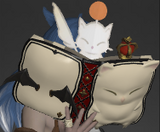
The Majestic Mogtome with a pop-up quill-wielding moogle.
- During the final phase of Alexander - The Soul of the Creator, Alexander Prime will sprout wings similar to Alexander's appearance in Final Fantasy IX.
- The Majestic Mogtome item, when unsheathed, is opened to reveal a pop-up moogle with a quill at the top, resembling the Save Moogles of Final Fantasy IX when viewed from the outside of the book.
- Zidane's outfit is available to players as a Veterans Reward for subscribing.
- A giant eye can be seen in the sky above
 Abyssos: The Eighth Circle during the Pandæmonium raid, referencing the Invincible and its owner Garland, who ruled over IX's Pandemonium.
Abyssos: The Eighth Circle during the Pandæmonium raid, referencing the Invincible and its owner Garland, who ruled over IX's Pandemonium. - The Viper job introduced in Dawntrail fights with twin swords that can combine into a single dual-edged sword, referencing Zidane's weapons in Final Fantasy IX and in particular his fighting style in Dissidia Final Fantasy.
- The Dawntrail location Solution Nine is named after Zidane's attack Solution 9.
- A minion based on Zidane is a bonus reward for pre-ordering Dawntrail.
- A minion based on Garnet and a mount based on Ark are included in the Dawntrail collector's edition.
Final Fantasy X[]
- (1.0) The server Besaid referred to an island of the same name from Final Fantasy X.
- (1.0) An NPC in the Miner quests mistakenly called players by the wrong name, calling a Midlander Hyur "Tidus," the protagonist of Final Fantasy X.
- During the main scenario for A Realm Reborn, Trachtoum believes that Titan's name is "Tidus."
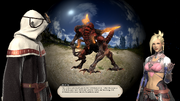
Minfilia explains the spirit energies of Hydaelyn.
- The circle of birth, life, and death in The Source works in the same way as Spira's. When a living being dies, it returns to the aetherial realm and reincarnates into a new life. The spirit energies in the realm are called "Lifestream", the term from Final Fantasy VII. Primals can be called from these energies similar to how the summoners in Spira call their aeons that manifest from pyreflies.
- Garlean machines are referred to as "machina," a term used in Spira to refer to machines before the Eternal Calm.
- Similar to Dream Zanarkand, the city of Amaurot is created by Emet-Selch from the memories of the original city. Like Dream Zanarkand, the inhabitants of the city live life normally and are unaware of their true nature.
- Anima appears as the final boss of the Tower of Babil. Like how Anima in Final Fantasy X was an Aeon created from Seymour's mother, this Anima is a primal created from Zenos's father.
- During the 2014 Heavensturn (New Year) event, during the year of the horse, an argument between the Chief "Chocowhacker" and the far eastern Uma Bugyo contains the following line: "As for your precious horses, they're just unicorns with a big empty forehead! Hornless! Hornless!" This alludes to Biran and Yenke Ronsos' mocking of Kimahri Ronso for his broken horn in Final Fantasy X.
- The region Amh Araeng has locations known as the ruins of Kelk, Mount Biran, Nuvy's Leavings, and Garik, all named after historical notes of the Ronso race. These names derive from Ronso characters Kelk Ronso, Biran Ronso, and Nuvy Ronso from Final Fantasy X and Garik Ronso from Final Fantasy X-2.
- In the realm of The First, the Hrothgar feline race are known as the Ronso, being named after the feline race of the same name from Final Fantasy X.
- The Eden Verse: Fulmination raid instance takes place on the Gandof Thunder Plains, being named after the character Lord Gandof and the Thunder Plains location from Final Fantasy X. The battlefield visually resembles the original Thunder Plains.
- The battle strategy for Forgall, the second boss of the Weeping City of Mhach, involves players getting a zombification debuff in order to avoid being killed by the boss' spell, Mega Death—the same strategy that the player can use during the fight against Yunalesca.
- Yojimbo appears as the last boss of Kugane Castle and is an important character in the Hildibrand storyline in Stormblood, using the same model as his Final Fantasy X counterpart. His ultimate attack Zanmato's damage depends on the amount of gold Daigoro collects. In Final Fantasy X, the player must pay Yojimbo gil in order for him to act in battle. Yojimbo also appears in the Manderville Gold Saucer during the GATE "The Slice is Right".
- The Relic Weapon for White Mages is Nirvana.
- Sari's title in battle is High Summoner, the title bequeathed to summoners who defeated Sin and bring about the Calm—usually posthumously—just as the Sari fought is a simulacrum of the summoner who had died long before.
- The Pelupelu Allied Tribe are based on the tribe of the same name from Final Fantasy X-2.
- Rikku, Yuna, and Lulu appear as minions.
- Tidus and Yuna's clothes are available for purchase from the online shop.
Final Fantasy XI[]
- (1.0) The server Selbina referred to a town of the same name.
- (1.0) Two of the Achievement NPCs bear the last name of "Ironheart," a reference to the famous cartographer Gwynham Ironheart. They are Milith Ironheart (in charge of Dungeons) and Nedrick Ironheart (in charge of Exploration). The two have switched roles after 2.0, as Milith is now the character who gives the adventurer access to the Sightseeing Log, and Nedrick is present as the quest giver for various dungeons apart from the main story, such as the Sunken Temple of Qarn and Amdapor Keep.
- (1.0) The NPC responsible for unlocking the battle category of achievements was named Atelloune, sharing her name with a minor NPC present in Final Fantasy XI. Both of them are researching monsters, wear the exact same outfit and are of similar races (Elvaan/Elezen).
- The original five playable races are derived from the Final Fantasy XI races.
- The design of chocobos are based on the chocobos from Final Fantasy XI.
- The original beastmen of the starting cities were likely derived from beastmen in Final Fantasy XI as well. The Ixal are flightless birds like the Yagudo, the Amalj'aa strongly resemble Mamool Ja, and the Kobolds are reminiscent of Goblins (or more specifically their subterranean brethren, the Moblins). Goblins and Mamool Ja were not introduced until long after 1.0's release.
- Several beast tribes, namely the Qiqirn, Mamool Ja, Gigas, and Goblins, are upscaled versions of their Final Fantasy XI models.
- The main scenario primal, Garuda, strongly resembles the design of the Final Fantasy XI Avatar, being a pale green winged woman.
- The Grand Companies lore are direct references to important characters and weapons from Final Fantasy XI:
- The first name of Raubahn Aldynn, the leader of the Grand Company Immortal Flames, is identical to Raubahn, the captain of the Immortals in Final Fantasy XI.
- Admiral Merlwyb Bloefhiswyn's firearm, the Death Penalty, is named after the Corsair Mythic Weapon.
- Kan-E-Senna wields the Claustrum, which is named after the Relic staff from Final Fantasy XI.
- The Alzadaal's Legacy main scenario dungeon is heavily inspired by several areas from the Treasures of Aht Urhgan expansion - the exterior areas being based on Caedarva Mire and Arrapago Reef, while the interior is based on the Alzadaal Undersea Ruins. In addition, several enemies from Treasures of Aht Urhgan also appear in the dungeon as normal enemies.
- The gatekeeper for the Ninja headquarters in Final Fantasy XIV speaks the word "Ayame", to which the password that must be replied is "Kaede". Ayame and her sister Kaede are both figures in the Ninja questline of Final Fantasy XI.
- The Pugilists' Guild's introductory statements refer to a woman named Cornelia, who founded the guild. This is a reference to a Monk of the same name in Final Fantasy XI.
- The mammet in the Goldsmith quest line, Gigi, is considered the first mammet. His original name is Mnejing.
- The Ghrah Luminary and its additional enemies in Pharos Sirius (Hard) are identical to the Ghrah enemies encountered in the Lumoria region of the Chains of Promathia expansion.
- A mammet by the name of Ovjang appears as a hunt in Central Thanalan, a reference to one of Aphmau's automatons.
- The recurring voidsent Diabolos is based on his Final Fantasy XI appearance. When fought, Diabolos uses Nightmare, Camisado, and Ruinous Omen; the former two being some of his Blood Pact abilities, while the latter was his Astral Flow skill from Final Fantasy XI.
- Fenrir appears as the final boss of Snowcloak, and both his appearance and his abilities (such as Lunar Cry) are similar to that of his Final Fantasy XI incarnation.
- The design of the Mamool Ja bosses from the Wanderer's Palace (Hard) are based on the Lancelord Gaheel Ja, Sagelord Molaa Ja, and Gulool Ja Ja Notorious Monsters from Final Fantasy XI.
- The enemies inside the hard mode version of the Lost City of Amdapor are upgraded models of the enemies from Final Fantasy XI. The Void Monk is based on the Sea Monk enemies, Mana Idols are based on the Doll enemy class, and the Mana Pots are based on the Magic Pot enemies.
- Among Eorzean NPCs, Thaumaturges are predominately Lalafell, much like how the Tarutaru of Windurst are strongly tied to Black Magic, particularly Shantotto.
- More specifically, Shantotto is frequently alluded to in all things relevant to the Black Mage job:
- A legendary female Black Mage named "Shatotto" was the bearer of the Soul of the Black Mage (BLM's Job Crystal, a.k.a. Shatotto's Stone), which was used to seal the voidgate.
- Shatotto was the creator and wielder of the original Stardust Rod. In the quest line to obtain the recreated rod, the relic smith Gerolt mistakenly calls her "Shantotto."
- She is also referred to by the achievement "Ohohohohoho!" granted by obtaining the Stardust Rod Relic Weapon.
- Black Mage's victory pose is based on Shantotto's iconic laughing.
- During the Level 60-70 questline, Shatotto will catch herself rhyming and questioning such a manner of speaking. This was Shantotto's character tic.
- Both the names of the artifact and vintage armor sets for all jobs (e.g. Healer's/Cleric's gear) are identical to the names of the two artifact armor sets in Final Fantasy XI.
- Numerous Miqo'te names are taken from Final Fantasy XI.
- Gilgamesh wields the Hauteclaire sword and the Ridill scimitar.
- Reisen Temple uses the same music as Reisenjima from Final Fantasy XI. It also includes references to Tenzen and multiple bosses interlinked in a similar concept.
- An NPC in the Weaver's guild sings the line "Distant worlds together. Miracles from realms beyond" from the song "Distant Worlds" in a speech bubble while she spins thread.
- Dawntraill's alliance raid series Echoes of Vana'diel is a crossover with Final Fantasy XI, similar to what the Return to Ivalice series was for Final Fantasy XII.
Final Fantasy XII[]
- (1.0) The server Rabanastre referred to a city of the same name from Final Fantasy XII.
- The bangaa, seeq, and viera races are native to the region of Dalmasca. Similar to Final Fantasy XII, the viera of The Source hail the Golmore Jungle and tend to avoid interaction with the outside world.
- The Imperial Legatus armor designs are similar in design to the Archadian Judges' armor from Final Fantasy XII.
- A scene with Gaius van Baelsar and his Tribunes during the events of A Realm Reborn resembles the Archadian Judges marching towards the screen during the opening of Final Fantasy XII.
- Members of the Ascians who worship Zodiark, are named after the Scions of Light mentioned in profiles on the Espers in Final Fantasy XII.
- When fighting the Ascian Nabriales during the Chrysalis trial, he will use certain abilities that first appeared in Final Fantasy XII. His damage over time attack, Blight, is named after the special attack of the same name used by the Esper Cúchulainn, who was the Scion of Darkness that opposed Nabriales, the Majestic. He also uses Dark IV (ダージャ, Dāja?, lit. Darkja) as his special attack during the battle, with Dark IV's spell animation strongly resembling Zodiark's Darkja spell used during the boss fight against it inside the Henne Mines.
- The character Venat, who went against the Convocation of Fourteen's wishes and led the summoning of Hydaelyn, is named after Final Fantasy XII's Venat, who went against the other Occuria.
- In the stinger for the Patch 3.1 Main Scenario Quest "As Goes Light, So Goes Darkness", Urianger discusses a book called the Gerun Oracles, which shares its name with the Occurian king.

Minfilia asking Uimet about her age.
- The scene of Minfilia asking the Viis Uimet about her age alludes to Vaan asking Fran her age in Final Fantasy XII. However, Uimet being asked in Final Fantasy XIV does not seem to be annoyed like Fran.
- Beq Lugg's disguise as the "Seeker of Solitude" is that of the Mindflayer from Final Fantasy XII, referencing the Piscodaemon hunt being a corrupt version of the nu mou.
- The primal essences that can be called forth by the Summoner are called egi, an allusion to Garuda-Egi in Final Fantasy XII.
- Likewise, the last battle from the Summoner quest line is against Belias-Egi, the essence of Belias, the first Esper the player is likely to fight in Final Fantasy XII.
- The Mandragora royals appear in a sidequest involving Hildibrand.
- In the "Return to Ivalice" arc, the Royal City of Rabanastre and Ridorana Lighthouse alliance raids are based on Rabanastre and the Pharos of Ridorana, and are located in the Dalmasca region. The raid series contains the following references to Final Fantasy XII:
- Rabanastre has much in common with its Final Fantasy XII counterpart, as both kingdoms are located in the heart of a desert region, contain an aqueduct system known as the Garamsythe Waterway, and both are the birthplaces of their game's versions of Princess Ashelia B'nargin Dalmasca.
- A version of Prince Rasler Heios Nabradia appears as a historical figure in the Return to Ivalice series. However, this version of Ralser is named Rasler B'nargin Dalmasca, and is part of the Dalmasca royal family as Ashelia's twin brother. Similar to his original counterpart, Prince Rasler is murdered in an imperial attack on the Dalmasca region.
- A version of Fran original to the world of Final Fantasy XIV appears. Her appearance is largely the same, albeit somewhat smaller than her original counterpart. She leads the Lente's Tears resistance, which was the name of an important key item needed to pass through the Golmore Jungle in Final Fantasy XII.
- Ba'Gamnan and his siblings appear as the initial antagonists during the opening portions of the "Return to Ivalice" series.
- Waypoints in the Rabanastre raid are modeled after the save points appeared in Final Fantasy XII.
- The Final Fantasy XII versions of Mateus, the Corrupt and Hashmal, the Bringer of the Order appear as the first two bosses in the Royal City of Rabanastre raid; while Famfrit, the Darkening Cloud and Belias, the Gigas also appear in a similar manner in the Ridorana Lighthouse. Like their appearances in Final Fantasy XII, these bosses use -ja tier spells (localized as IV-tier spells) and their signature attacks when summoned as Espers.
- Argath Thadalfus's Duma Lucavi design is influenced by Chaos, Walker of the Wheel, the Esper from 'Final Fantasy XII that represented the Taurus Zodiac. Like Chaos, Argath is presented as a bull-like creature that wields four swords in battle.
- Yiazmat appears as the final boss of the Ridorana Lighthouse raid. His appearance in Final Fantasy XIV is somewhat similar to the superboss's original appearance.
- Ultima, the High Seraph also appears as the main antagonist of the Return to Ivalice series. While not directly resembling her Final Fantasy XII appearance, her overall design bears some resemblance to it, albeit lacking a mechanical bottom half. In addition, she is able to use Holy IV and Redemption, referencing her special attacks in Final Fantasy XII.
- A version of Gabranth, Noah van Gabranth, appears in the epilogue of the raid series as the Legatus of the IVth Imperial Legion, and wears armor identical to his original appearance. He is the son of Basch van Gabranth, unlike his original appearance where both Basch and Gabranth are twin brothers.
- Many creature designs from Final Fantasy XII are reused for normal enemy models since the relaunch of Final Fantasy XIV. Enemies include: Basilisks, Feral Crocs, Mirrorknights, Mantises, Spinner-Rooks, Sphere-Rooks, Plate Wyrms, Mimics, Golems, Reapers, Slavens, and Bombs.
- The first boss of Halatali is named Firemane; curiously, the model for the creature is that of a "normal" fire elemental.
- The Qarn Facer enemies and the Adjudicator boss inside the Sunken Temple of Qarn use the same models as those of the Miriam Facer and Miriam Guardian enemies from the Stilshrine of Miriam, but again with substantially updated textures.
- The Stone Vigil boss, Chudo-Yudo, reuse the model and texture of the Ring Wyrm (sans its iconic rings).
- Tyrant appears as a mini-boss in the original Pharos Sirius.
- The Stone Vigil Hard Mode boss, Gorynich, reuses a model and design similar to that of the Fafnir mark.
- Giruveganaus, the last boss, is based on Giruveganus.
- The Griaule boss in the Dohn Mheg dungeon borrows design elements from the Elder Wyrm, appearing as a wyrm-type enemy covered by vegetation.
- The Terminus Bellwether boss in the Amaurot dungeon reuses the model of the Lesser Chimera from Final Fantasy XII.
- Like "Return to Ivalice" before it, the "Save the Queen" storyline features references to Final Fantasy XII:
- Adrammelech appears as a boss in Castrum Lacus Litore. Unlike his Final Fantasy XII incarnation, he does not exclusively use lightning-aspected attacks.
- Cuchulainn appears as a boss in the Dalriada, this time with his model from Final Fantasy XII. He has disease- and putrefaction-themed attacks as well.
- New versions of Shemhazai, Belias and Famfrit appear as powerful enemies in the Zadnor fields, employed by the 4th Imperial Legion.
- Equipment resembling the Judges' Armors from Final Fantasy XII can be obtained with gold Bozjan coins, and the equipment of Basch, Penelo and Larsa can be obtained with platinum coins.
- The 4th legion, the imperial force in control of Bozja and Dalmasca, serves the role of the Archadian Empire in Final Fantasy XII, with Noah Van Gabranth as its legatus. Unlike in that game, however, he is not yet faced in battle by the player in Final Fantasy XIV.
- Save the Queen is a weapon from the Final Fantasy series, including Final Fantasy XII. in Final Fantasy XIV, it is a powerful artifact related to the Bozjan Civilization and their queen, Gunnhildr.
- Various themes from Final Fantasy XII: The Zodiac Age are included in both storylines, such as Battle with an Esper, Giving Chase, and the Sochen Cave Palace theme.
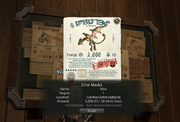
The hunt board.
- Players can accept hunt requests from billboards run by all three Grand Companies, alluding to the hunt sidequests in Final Fantasy XII. Each expansion also has their own additional hunt billboard.
- Clan Centurio makes an appearance in Heavensward. Returning as a clan of hunters, they give players mark bills and reward them with Centurio Seals upon defeating Marks. In Final Fantasy XII, Clan Centurio is an elite hunting club the player can join.
- Wanted enemies will have a Tomato King icon above their name.
- The Gnath beastmen are modeled after the Urutan-Yensa.
- Kuribu, the final boss of the hard mode version of the Lost City of Amdapor, uses the Reverse and Decoy abilities, spells that first appeared in Final Fantasy XII.
- Balthier's outfit appears as the ranged DPS exclusive gear in the Orbonne Monastery alliance raid. In addition, an official screenshot released by Square Enix to promote the "Return to Ivalice" arc features a player character who resembles Balthier.
- The King Tomato minion alludes to the Rogue Tomato mob with a quote: "It is apparently a rogue, outcast from its kin, a stranger in a strange land" attributed to Tomaj. In Final Fantasy XII, Tomaj tasks Vaan to fell the Rogue Tomato as the first hunt.
Final Fantasy XIII series[]
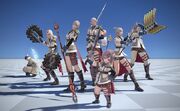
Lightning's outfit, Snow's outfits, and weapons from the Lightning Saga.
- (1.0) The server Bodhum referred to a city of the same name from Final Fantasy XIII.
- The survivors of the Thirteenth reflection of the Source reference some of the protagonists of Final Fantasy XIII.
- Unukalhai of the Scions of the Seventh Dawn is similar to Hope Estheim, both being silver haired boys that were gifted with unique powers when they were barely inexperienced children. After the events of Reflections in Crystal's main scenario quests, Unukalhai takes the initiative into looking for methods to restore the Thirteenth, mirroring Hope's role in Final Fantasy XIII-2 of trying to restore Cocoon.
- Cylva of the Warriors of Light of the First is similar to Oerba Yun Fang, being the sixth member of their respective parties and betray their comrades for the sake of saving something dear to them. In addition, both characters transform into the prophesized creatures that serve as the destroyer of their opposing worlds - Fang being Ragnarok and Cylva being the Shadowkeeper.

A player Gunbreaker performing Lightning's battle stance.
- Players who participated in the Full Active Time Event, "Lightning Strikes," could acquire a Lightning and Snow costumes, and weapons from Final Fantasy XIII, Final Fantasy XIII-2, and Lightning Returns: Final Fantasy XIII. These items were eventually released on the game's Mog Station online store.
- Ruin appears as an Arcanist ability. It shares the same animation and effect with its Final Fantasy XIII counterpart.
- Female Gunbreaker-players use Lightning's battle stance, when their weapons are drawn outside of combat.
- Automata and beast enemies from both Gran Pulse and Cocoon are reused as enemies in Allagan-related dungeons. In addition, several PSICOM enemies are used during the Ostrakon Okto portion of the Dead Ends dungeon.
- Zaghnal makes an appearance in the Twinning dungeon as minor enemies. A stronger variant named Alpha Zagnal appears as the first boss of the dungeon. Additionally, the second boss of the same dungeon, Mithridates, uses the same name and character model as the Undying Cie'th of the same name.
- The Aspect of Chaos, the last boss of the "Lightning Strikes" event, shared the same model with Chaos Bahamut.
- Ultros appears as a smaller version of how he appeared in Final Fantasy XIII-2. When he loses to the party, he gets cooked up in a similar manner.
- In the quest "Rolling With The Snowies" in Coerthas Central Highlands, the snowman says "Revolutionaries always get called crazy." The same line was used by Fang in Final Fantasy XIII.
- An NPC in the All Saints' Wake 2014 event quest "Yes We Cant" uses the phrase "sugar and rainbows." "Sugar and rainbows" was said by Sazh Katzroy in Final Fantasy XIII.
- The Manderville Gold Saucer sidequest name "So You Think You Can Ride This Chocobo" refers to the lyrics from the "Crazy Chocobo" theme from Final Fantasy XIII-2.
Final Fantasy XV[]
- "A Nocturne for Heroes" was a Final Fantasy XIV x Final Fantasy XV collaboration, which allowed players to fight alongside Noctis.
- Noctis's vehicle, the Regalia, was obtainable as a mount in the event.
- Noctis's gear and hairstyle were also obtainable in the event.
- The musical themes Hammerhead, Valse di Fantastica, Relax and Reflect, Veiled in Black, Apocalypsis Noctis, and A Quick Pit Stop were also obtainable for the Orchestrion.
- The event hosted several fights against different enemies from Final Fantasy XV: such as the Magitek infantry, a Magitek armor, Iseultalon, and Garuda.
- Several references to Final Fantasy XV are made, such as camping, photos, and Noctis' fishing hobby.
- Cid, Gladiolus, Ignis, Prompto and the Niflheim empire are mentioned. Also, Lunafreya makes a cameo at the final moments of the event.
- During the Garuda special fight, the player can use the Warp-strike Duty Action.
- Completing the event rewards the player with the "Kingsglaive" title.
Final Fantasy XVI[]
- A collaboration event with Final Fantasy XVI titled The Path Infernal released in April 2024.
- Clive Rosfield arrived in Eorzea with amnesia, and worked together with the Warrior of Light to defeat Ifrit and regain his memories.
- During the event Clive is shocked at the existence of flying airships in Eorzea, as airships in Valisthea are all ancient ruins that don't work.
- Clive's reaction to an Aetheryte is to briefly wonder if it is a Mothercrystal before dismissing it as too small.
- Clive overhears Gridanian soldiers talking about Garuda, which reminds him of his fight with Benedikta Harman.
- Rewards for the event included Clive's outfit, and a mount and minion of his companion Torgal.
- Many orchestrion rolls of songs from Final Fantasy XVI could be bought at the Gold Saucer for 20,000 MGP each.
Final Fantasy Type-0[]
- Several models of Milites Magitek enemies from Final Fantasy Type-0 are reused in the Bozjan Southern Front as enemies and bosses.
- The hairstyles of Class Zero cadets are available for player characters. Cater, Cinque, Nine, and Jack's hairstyles were made available since version 3.2. Seven's hairstyle was implemented later in version 3.3. Ace, Queen, and King's for version 3.4, and Deuce, Trey, and Sice's for version 3.5.
Final Fantasy Tactics[]
- When Cid nan Garlond hides his identity while living in Thanalan, he wears a brown hooded cloak similar to the Cid of Final Fantasy Tactics, Cidolfus Orlandeau. This similarity is brought up during the Orbonne Monastery raid. Upon encountering Cidolfus, an NPC initially mistakes him as Cid.
- There are several references to a Corpse Brigade led by Milleuda the Slitter, in Full Active Time Events and guildleves.
- In a main story quest, a line is uttered by the cowardly merchant, Ungust, that quotes, "Spare me your contempt! If you want to blame someone for the mess the world's in, blame yourselves or the gods!" A line Delita Heiral says in the beginning of the PS version of Final Fantasy Tactics to Princess Ovelia Atkascha (it was changed to "'Tis your birth and faith that wrong you... not I" in the War of the Lions version).
- In the Japanese version, Lahabrea's incantation for casting Ultima during the cutscene inside the Praetorium is loosely based on Ultima's incantation for her Divine Ultima ability when fighting her in the Airship Graveyard.
- The dark deity Zodiark is represented by a character called Elidibus, named after an optional superboss fought at the bottom of the Midlight's Deep in Final Fantasy Tactics; Zodiark appeared as a summon used in battle by Elidibus, who was implied to have pledged his soul to the dark being.
- Y'shtola, under the alias of Master Matoya, lives in cavern civilization near the ruins of the Ronkan civilization on the First, referencing the Matoya's Cave Wonder from Final Fantasy Tactics.
- The Veil of Wiyu and the Omnilex are the Summoner and Scholar relic weapons.
- Construct 8 appears as an enemy in Pharos Sirius (Hard).
- In the "Return to Ivalice" raid series, the a character named Arazlam Durai appears under the stage name Jenomis Lexentale, with two of his children named after Ramza and Alma Beoulve: Ramza bas Lexentale and Alma bas Lexentale.
- Cid Garlond and Jenomis are old friends, echoing Cidolfus Orlandeau and Barbaneth Beoulve's past friendship in Final Fantasy Tactics.
- Argath Thadalfus appears as the last boss of the Royal City of Rabanastre. This version of Argath becomes a Lucavi, mimicking his original counterpart's fate of becoming a servant for the demons in the War of the Lions versions of Final Fantasy Tactics.
- Ramza Beoulve, Alma Beoulve, Delita Heiral, and Orran Durai are mentioned.
- The death of Delita's sister was mentioned and is guessed to be the cause of Delita and Ramza to went separate ways.
- The Orbonne Monastery appears as an alliance raid. Similar to the original location from Final Fantasy Tactics, the monastery also serves as an entrance to the Necrohol of Mullonde and ultimately leads to a final encounter with Ultima, the High Seraph.
- Ramza and Alma's hairstyles are available for player characters since version 4.5.
Final Fantasy Tactics Advance[]
- Similar to Queen Remedi summoning the Totema to aid her during the final encounter, Ultima, the High Seraph summons Famfrit, Belias, and Hashmal to aid her during her final encounter within the Orbonne Monastery raid.
- The Crystarium's hunting clan, Clan Nutsy, is named after Marche Radiuju's clan of the same name from Final Fantasy Tactics Advance.
- The nu mou race present in-game as of the Shadowbringers expansion take their appearance from this game rather than their Final Fantasy XII appearance.
- The porxie Ezel II, from the Pixie beast tribe quests, is named after "a hermetic of unrivaled skill."
Final Fantasy Tactics A2: Grimoire of the Rift[]
- A moogle by the name of Hurdy appears during the "Return to Ivalice" series, referencing the character of the same name from Final Fantasy Tactics A2. Like the original Hurdy, this version is also the brother of a moogle named Montblanc and is a bard.
- Vaan's sky pirate attire from Final Fantasy Tactics A2 appears as the melee DPS exclusive gear from the Ridorana Lighthouse raid.
Dissidia Final Fantasy[]
- Character artwork drawn for the covers of Dissidia and Dissidia 012 by Tetsuya Nomura were reused in legendary Triple Triad cards (see "Triple Triad" below).
- Chaos's ultimate attack in the Alphascape V1.0 raid is Soul of Chaos, which appeared as Garland's EX Burst in Dissidia Final Fantasy.
- The intro cutscene of The Voidcast Dais has Golbez pose in an identical to his idle stance in the Dissidia series.
- Golbez augmenting his sword by having the Shadow Dragon wrap around his blade is similar to his EX Mode where it wraps around his entire body.
- The conflict between Hydaelyn and Zodiark mirrors that of Cosmos and Chaos. Their respective counterparts also embodied order and discord with Hydaelyn presiding over all matter of stasis and Zodiark of activity.
- Hydaelyn also imparts Crystals to her chosen warriors and were earned by overcoming trials, usually by defeating a powerful foe. Both have also shared their power with their allies and weakened themselves as a result.
Dissidia Final Fantasy NT[]
- The Wind-up Kefka's description mentions that Y'shtola finds Kefka eerily familiar, which references to her encounters with Kefka in Dissidia Final Fantasy NT.
- Elidibus takes on the appearance of the Warrior of Light during The Seat of Sacrifice trial. His appearance shares the same model of the Warrior of Light, while his abilities are based on his Dissidia movesets.
- The Eden Cloud of Darkness is based directly on its appearance in Dissidia NT with the title being based on the name of its default costume. Its Summon ability conjuring green monochromatic copies of itself are based on its Manakin version.
- Golbez's trial fight uses many of the same moves as shown in Dissidia NT such as Terrastorm, Lingering Spark and Gale Sphere. His Twin Meteor is also visually inspired by NT. Like Cloud of Darkness, his title is based on the name of his default costume.
- At the beginning of the initial fight between Vrtra and the transformed Azdaja, the latter attacks with a magic spike suddenly jutting up from underneath him, similar to Black Fang's depiction in the Dissidia games
Final Fantasy Crystal Chronicles: The Crystal Bearers[]
- One of the titles that can be earned is "Crystal Bearer."
The Chocobo series[]
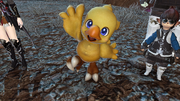
Alpha.
- The design of the chocobo Alpha is based on the chocobo from Final Fantasy Fables: Chocobo Tales. It frequently does the same pose as its original character.
- Yotsuyu's arc is quite similar to Irma from the Final Fantasy Fables games, with both previously being main antagonists but losing their memories and becoming friendly with the protagonists.
Bravely Default[]
- Rowena mentions the phrase "Flying Fairies," a reference to the Japanese title of Bravely Default, known as Bravely Default: Flying Fairy.
Final Fantasy: The Spirits Within[]
- One Paladin skill is named Spirits Within.
- The Wild-Eyed Swordsmen fought in the Akh Afah Amphitheatre have an ability called Spirits Without.
Final Fantasy Adventure[]
- On The First, Watts is the name of a legendary Dwarf blacksmith, who has several items and locations named for him. Watts is a Dwarf blacksmith in Final Fantasy Adventure.
Triple Triad[]
- Thirteen lead protagonists of the past thirteen main Final Fantasy titles appear as a legendary card using their Dissidia artwork. A Noctis card was also added later:





